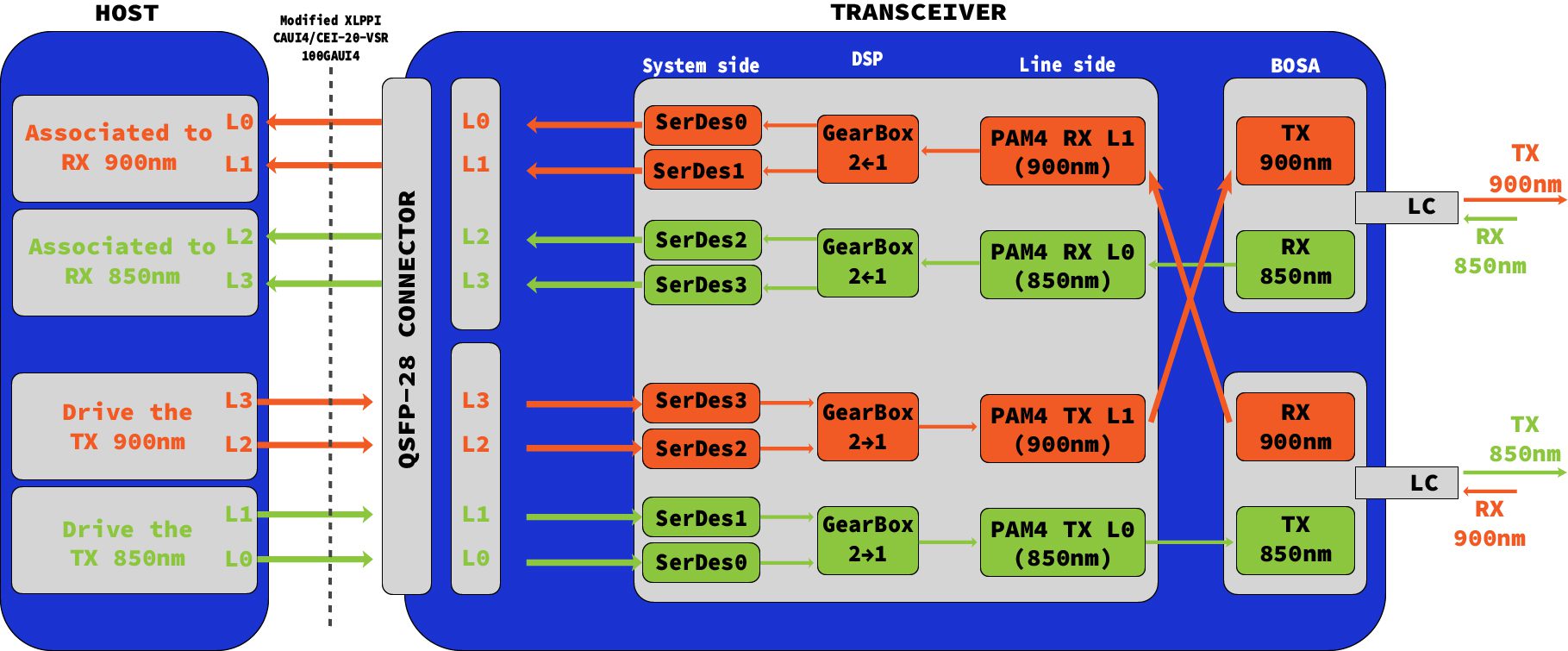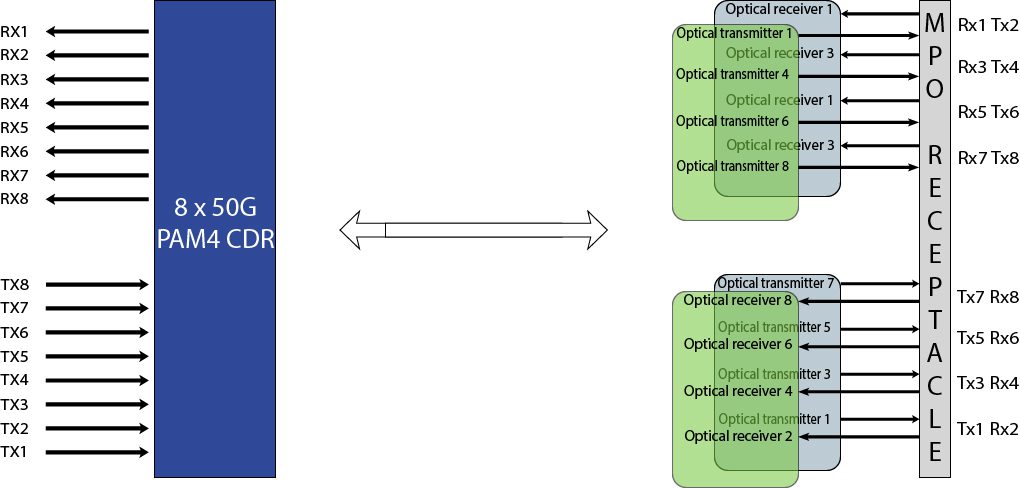
BIDI transceivers – The Future in 100G Era
Introduction
BIDI transceivers – The Future in 100G Era, where cloud computing and 5G networks, data centers have the tendency to develop at a higher speed, we see that the demand for 100G optical solutions is increasing and now it is the base of any operation. 100G currently provides the most energy, space, and cost-efficient way to meet this demand. In recent years, transceiver costs for 100G networks have also dropped significantly, including the initial outlay and ongoing associated costs. Moreover BIDI SFP, 10G to 25G to 100G provides a clearer migration path to upgrade to higher speeds with a roadmap to higher data rates in the coming years. These are just a few facts that 100G can meet the leads of most links. From 2022 data more than 90% of fiber links in small and medium-sized data centers are less than 100 meters in length. 70% of fiber links in large data centers are less than 100 meters in length, and more than 80% of them are less than 125 meters in length. To sum up, for 100G modules, the largest demand is for the 100G multimode optics.
Short History of Bidirectional transceivers:
First BIDI transceivers (BIDI) were introduced more than 20 years ago. In mid 2001 the first 100M and 1G optical BIDI transceivers were developed and standardized. Bidirectional transceivers got their abbreviation BX and firstly they had one SC connector. Latter it was replaced with much smaller form LC type connector. Bidirectional fiber optic communication offers greatly lower expenses towards optical fiber link resources because transmission can be achieved through one optical fiber strand. The optical fiber pair as required with the Double Fiber transceiver technology was no longer required.
Bidirectional technology was introduced as well in 10G and as time went by also in 25G, 40G and 100G optical transceivers. Most modern BIDI transceivers offers even two LC ports where each of them works as Bidirectional entity.
Bidirectional 100G optics
For short range optics over multimode we provide BIDI-100G-QSFP28-151 and BIDI-100G-QSFP28-150.
BIDI-100G-QSFP28-151 is a Bidirectional QSFP28 module. The module integrates four host electrical data into two optical lanes (by Dual Wavelength VCSEL Bi-Directional Optical Interface, 850nm and 900nm) to allow optical communication over a 2-fiber duplex LC optical multimode fiber. Reversely, on the receiver side, the module de-multiplexes 2 sets of optical input signals and converts them to 4 channels of electrical data. Module has a minimum guaranteed optical budget of 1.9 dB which in most cases is enough to reach 150 meters distance over OM5 multimode optical cable. The product is designed with form factor, optical/electrical connection and digital diagnostic interface according to the QSFP28 Multi-Source Agreement (MSA).
What is BIDI? BIDI-100G-QSFP28-150 is a more advanced BIDI transceivers than BIDI-100G-QSFP28-151, because it is not just a 100GBASE Bidirectional SR QSFP28 module, but also is compliant to 40GBASE. Its function is just as same as the BIDI-100G-QSFP28-151, which is mentioned in the above paragraph. As well it has the same 1.9 dB of optical budget guarantee and can reach up to 150 meters distance over OM5 multi-mode optical cable.
The only difference between the two modules is only the data rate advantages. The schematic image of both modules can be seen in the image below.
Short Wavelength Division Multiplexing 4 optics
Short Wavelength Division Multiplexing 4 is similar to 100G BIDI transceivers, both have a duplex LC interface, where SWDM (Short Wavelength Division Multiplexing) refers to short wavelength division multiplexing technology. The MUX/DMUX tech enables the transmission of 4 (hence the name SWDM4) bands of optical signals on a single core of multimode fiber. The four bands are in the wavelengths 850nm, 880nm, 910nm and 940nm.
For SWDM4 modules we provide solutions for 40G data rates, 100G data rates and also both 40G & 100G:
Bidirectional 400G optics
Bidirectional 400G SR4 module has an MPO interface and ir is designed for QSFP-DD SR4.2 to QSFP- DD SR4.2 point to point communication and QSFP-DD SR4.2 (BIDI-400G-QSFP-DD-150) to 4x QSFP28 SR1.2 (BIDI-100G-QSFP28-151) breakout communication. The 400G BIDI transceivers accepts 8x 50G (400GAUI-8) host electrical data and transmits them in two groups of optical Bi-Directional lanes (each group contains 4 pairs of optical lanes) to allow optical communication over optical Multi-Mode fibers. Reversely, on the receiver side , the module accepts 8 sets of optical input signals and converts them to 8 channels of electrical data.
Summary of EDGE BIDI Short Reach modules
| SKU | Data rate | Technology | Distance | Optical budget | Wavelengths |
|---|---|---|---|---|---|
| BIDI-100G-QSFP28-151 | 103.125 Gbps | PAM4 | 150m(OM5), 100m(OM4), 70m (OM3) | 1.9 dB | Ch1:850nm; Ch2:900nm |
| BIDI-100G-QSFP28-150 | 41.25-103.125 Gbps | PAM4 | 150m(OM5), 100m(OM4), 70m (OM3) | 1.9 dB | Ch1:850nm; Ch2:900nm |
| BIDI-400G-QSFP-DD-150 | 425 Gbps | PAM4 | 150m(OM5) | 2 dB | Ch1: 850nm, Ch2: 908nm |
| SWDM4-40G-QSFP-350 | 41.25 Gbps | SWDM4 | 350m | 4.5 dB | Ch1:850nm, Ch2: 880nm, Ch3: 910nm, Ch4: 940nm |
| SWDM4-100G-QSFP28-150 | 103.125 Gbps | SWDM4 | 350m | 3 dB | Ch1:850nm, Ch2: 880nm, Ch3: 910nm, Ch4: 940nm |
| SWDM4-40-100G-Q28-440 | 41.25-103.125 Gbps | SWDM4 | 100G: 75m (OM3), 100m (OM4), 150m (OM5) 40G: 240m (OM3), 350m (OM4), 440m (OM5) |
2.2 dB | Ch1:850nm, Ch2: 880nm, Ch3: 910nm, Ch4: 940nm |
Will be happy to hear your requirements – contact us!




